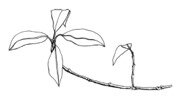About the Trails
CCC Loop
As you glide through the CCC Loop, notice the old foundations and stone chimney. These are remains of a Civilian Conservation Corp (CCC) camp from the 1930's. This camp, #22, SP-4, Company 209, and others like it throughout the country, housed young unemployed men whose projects provided the momentum for creating a system of state and national parks in the United States. At Fahnestock, the crew built many park structures including the campground, stone shelters, dams and some of the trails you are using today.
Hemlock Grove
This trail offers skiers a chance to view some of the oldest hemlock stands in the mid-Hudson Valley. Many of these stately, slow-growing trees are being damaged or killed by a non-native insect, the Hemlock Woolly Adelgid (Adelges tsugae); this tiny, aphid-like insect literally sucks the life out of the tree and can kill it in as little as four years. Each year more trees die; soon they will all be gone. As they die, more sunlight will reach the forest floor, and the types of plants that grow here will change dramatically. Deciduous trees will begin to grow, eventually resulting in a climax hardwood forest.
Old Pasture Loop
Stone walls mark the boundaries of family farms that were located on this land in the mid 1800’s. Most of these farms were deserted when their owners moved to cities in search of jobs during the Industrial Revolution. By 1871, it was estimated that 252,000 miles of stone walls existed in New York and New England, enough to wrap around the earth ten times!
Mt. Laurel Loop
Much of this scenic trail is surrounded by mountain laurel. These shrubs retain their leaves all year, adding splashes of green to the winter landscape. Its scientific name, Kalmia latifolia, was given by Carolus Linnaeus, father of scientific nomenclature, in honor of Peter Kalm, the Swedish botanist. Kalmia is for his last name, and the second word means “broadleaf”. In early June, when the laurels are in full blossom, the entire forest seems to glow with their beautiful pink flower clusters . Native woodland people such as the Wappinger and Mahican called mountain laurel “Spoonwood” and made spoons from the base of the branches.
Appalachian Way
A part of this wilderness snowshoe trail traverses the Appalachian Trail (AT). The AT runs from Springer Mountain, Georgia to Mt. Katahdin, Maine, a distance of 2150 miles. The AT is marked with white rectangular blazes painted directly on the tree.
Ojigwan Path
"Ojigwan" means "tail of the snowshoe". Strap on your snowshoes and enjoy this 2.5 hour hike through hemlock groves and stands of mountain laurel. Look for signs of deer-tracks, scat, and "deer yards", areas of scraped-up snow where deer shelter for the night. You might also hear or see Golden-crowned Kinglets, tiny northern birds that somehow survive bitter cold nights on a diet of inchworms.






